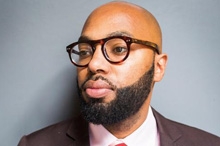

Dr. Christopher Emdin is being honored as an African American STEM Champion of Change.
Over the last few years, I have had the opportunity to visit hundreds of science classrooms. Many of them have been in the most socioeconomically challenged communities in the United States. These are communities where incarceration rates are high, graduation rates are low, and young people are so preoccupied with making it through each day that they view dreaming about a better future as a luxury they cannot afford. Like their students, educators who work within these communities are so preoccupied with the basic daily operation of schools that they see the work of creating the next generation of scientists as a luxury they cannot afford. In these communities - where seemingly insurmountable everyday challenges threaten possibilities for the future, thinking about the future or paths towards improving it are perceived as a foolhardy exercise. Oftentimes, this means that engaging students in science, technology, engineering and mathematics (STEM) is perceived as a hindrance to surviving the immediate and ever evolving everyday challenges/requirements of urban teaching.
There is a culture of immediacy that permeates many urban schools that makes it challenging for teachers to engage deeply in STEM. This culture is driven by the fact that these schools are mandated to look and sound exactly like what many consider to be the best schools - that are geographically and culturally far away from urban America. This expectation to be like the “best schools” plays out as a never-ending set of rules and expectations in urban schools that is intended to force them to have the same test results and graduation rates as schools with very different ethnic, racial, and cultural compositions. While the expectation of similar results is a necessary one, we fail to recognize that the path towards those results must look different in different schools.
If education in the most under-resourced communities becomes driven by how closely these schools can follow new mandates, shifting curriculum, and ever-evolving guidelines, educators become bound by the chase of trying to do all they are asked. They become so preoccupied with this process that they do not have the space or time to think deeply about new approaches to teaching and learning that will turn their students on to STEM careers.
As urban schools grapple with following the approaches to teaching implemented in other communities, and as they attempt to follow the cultural guidelines that are the norm in other schools, they do not have the space to focus on approaches to teaching STEM that are best for their students. Concurrently, schools who are not expected to shift their practice every new school year, and who do not have to teach any differently than they always have, continue to prepare their students for STEM careers successfully. This results in the persistent achievement gaps between schools that serve affluent culturally monolithic populations and diverse urban schools that primarily serve youth of color. In turn, these achievement gaps create a sense of alarm that results in more mandates and guidelines in communities that actually need less restriction so they can meet the unique needs of their students. As long as we expect all schools to be the same while schools that underperform are not allowed to truly engage their students, students in these schools will continue to see STEM as something for “other students” from “other neighborhoods” with “other family structures.”
Currently, STEM is seen as a set of subjects for the “best and brightest.” Historically, the best and brightest have been those with the most stable school and family structures with modes of instruction that are culturally aligned to their everyday experiences. Furthermore, the toughest or the most resilient have not been seen as being able to be a part of the best and brightest. My work challenges this history and fights the notion that students’ circumstances are an accurate tool for defining their potential academic success.
I suggest that engaging populations that are least represented in STEM requires that the classroom be malleable enough to allow the students’ unique art and culture to drive the instruction. This does not mean that we sacrifice high expectations or are less rigorous. It does mean that teaching styles must be unique to each school, and STEM instruction must be reflective of the arts and culture in the community of the school.
Incorporating the arts into STEM is part of a growing international movement called STEAM (science, technology, engineering, arts and mathematics). This approach requires that schools work with teachers to incorporate youth art and culture into the teaching, and the quality of instruction is based on how well the art and culture of the student is included in the teaching, and not on how close the urban school follows the pattern of schools in other communities. To STEAM ahead means that we use the arts to allow young people to see themselves in STEM. It validates youth who write raps about science, allows spoken word poetry about engineering concepts, and welcomes social media as a platform for sharing STEM news with youth. Moving full STEAM ahead considers motivating youth to participate, and building their self-confidence as the first two steps in preparing them for STEM careers. Most importantly, it considers the cultural art forms that youth engage in outside of the classroom as the pathways to introducing them to STEM disciplines and careers.
As a trained research scientist, I recognize the hard work required to fully engage in STEM. I have experienced the effort it takes to gain a command of the complex mathematical knowledge required to do my work. I have had to work hard to develop the skill to create and manipulate technology so I could conduct my research. I have experienced the attention to detail required to construct and test complex engineering models. However, I also realize that young people whose schools don’t allow them to see themselves as a part of STEM will never get to the point where they can appreciate the wonder and beauty of STEM.
Many say that it is easy to grab the attention of just about any child when they are introduced to a cool chemistry experiment or the physics of roller coasters. I respond by saying that in many urban schools populated by youth of color, the school is so preoccupied with trying to make students shed their culture that there is no space for innovative pedagogy that includes cool experiments and real life examples. In many schools, educators are so busy following scripts that they have no space to truly do STEM. As a result, students are so disengaged in STEM by the time they reach high school that the first time they are challenged academically, there is no passion in place to help them to overcome the academic struggle.
How is it possible that a student who is resilient enough to overcome missing meals, a broken family, and tough everyday circumstances cannot overcome the rigors of an introduction level STEM course? The answer lies in the absence of a motivation to engage. If the cultural connection to the discipline is non-existent, and the education that is being received does not ignite the passion of the student, we will not create STEM professionals. To increase access to STEM for all students, we must move full STEAM ahead. I am honored to be acknowledged by the White house for promoting this approach.
Christopher Emdin, Ph.D is an Associate Professor of Science Education at Teachers College, Columbia University, where he also serves as Director of Science Education at the Center for Health Equity and Urban Science Education.


